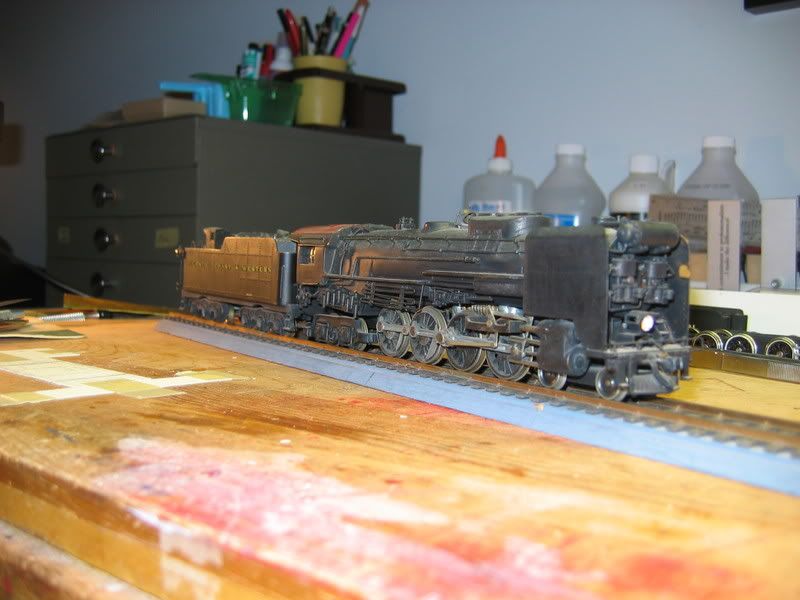After assembling a Bowser Big Boy and test running it, i want to paint it. How would I do it?
CB&O, I am sure Darth Santa Fe can tell you how.
Cuda Ken
Painting steamers has two sticky problems.
-
Keeping paint out of the works. You can take the locomotive apart and just paint the parts that show and don’t move. Or you can mask stuff off. The pros do both.
-
Getting the paint to stick to metal. First degrease everything thoughly. Hot soapy water, lacquer thinner, pine sol, something. A trip thru the dishwasher does a pretty good job. Once degreased, don’t touch the metal with bare hands, they leave fingerprints. Let dry overnight to get the last drops of water out of the nooks and crannies.
Then a coat of real primer. Use dark auto primer from the auto parts store. They sell to auto machanics who need it to stick on never too clean automobiles. The market is competitive and the leading brands have the best stick-to-metal chemistry available. It has lots of pigment and covers everything, nothing under the primer shows thru. The hobby paint companies sell stuff called primer, but you never know if it has real stick-to-metal chemistry, or merely a bright primer color. Stick with the stuff sold to working auto mechanics.
Get the primer coat good and dry. Gentle heat can help. The auto primer is a fine steam locomotive color, very flat, appears nearly black under layout lighting. Takes decals well. My steamers all sport coats of primer. However, if desired, a coat of engine black can be sprayed on top of the primer.
Final hint. Get some brass blackener (Hobby-Black) and blacken the brass detail parts. Then if your paint chips off later, the chip shows dark instead of bright yellow brassiness.
dstarr gave some pretty good tips there. I’ve never used auto primer before, but it should work very well (I usually use Testors spray can primer, and it’s worked great every time). I’ll go ahead and tell you my own process for painting.
I always disassemble what I’m painting completely. It makes it easier to completely paint each part, and there’s no chance of the paint getting into the mechanical parts. I also leave off the details that will cross different colored areas (like handrails), and then brush paint and put them on later. It’s difficult masking around detail parts, so that’s why I do it. All the parts are cleaned with soap, warm water, and a toothbrush.
When painting something like the frame, completely mask off any parts where there will be something like an axle. I usually cut out little squares of tape that are just big enough to do the job.
Will you be painting the boiler the usual black and graphite? If so, spray on the graphite/dark gray first. It doesn’t need to be masked. Once it’s completely dry, mask off all the graphite areas with blue painter’s masking tape. The painter’s masking tape has just enough adhesive to hold in place, but it won’t peel the paint off like stronger tan masking tape might do. Once you’ve masked off everything you want, coat it with the black paint.
Once the paint is dry, take the masking tape off and add the rest of the detail. If your paint has a flat finish where the decals go, you may want to put a gloss coat over the whole engine for when you put the decals on. Decals look better over a shiny surface, because the smoothness won’t trap air like a flat finish will. After the decals are on and set with something like Walthers Solvaset, put on the finishing clear coat of flat, semi-gloss, or gloss (depending on what you want).
If you use a clear coat like from Testors or Model Master spray cans, it should be completely d
With a brush, or a spray can, or an airbrush! A brush would be good for you.
I am surprised that the stove polish I used to paint my Bowser Mountain 40 years ago, has stood the test of time. I wish they still made this product. Peter Smith, Memphis 
I think they still do. I put Stove Polish into Google and came up with a bunch of choices.
Years ago I made a search for substitutes for Fyr-Pruf stove polish that I used on my Bowser. I came up with several but none worked at all for painting my locomotives. I assumed that the old stuff was banned due to environmental reasons. Has anyone tried the new stuff? Peter Smith, Memphis